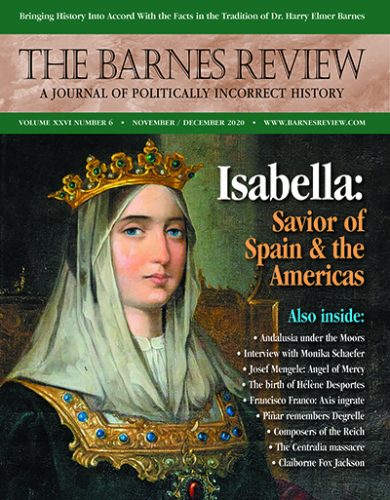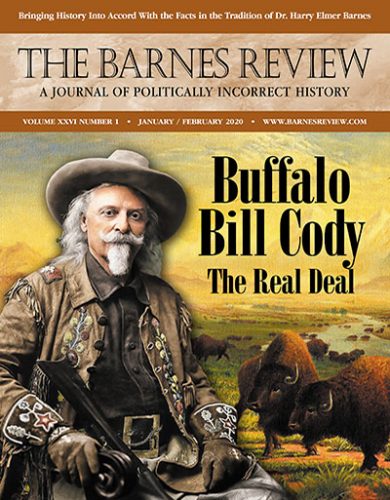Description
From The Barnes Review, July/August 2023
Personal From the Editor
PUSHED TO THE BRINK
It seems the investigation into the January 6, 2021 protests at the U.S. Capitol will never end. Every week we hear news that one or another granny is being hunted down by agents of the FBI for participation in the “insurrection” they allege occurred that day. For the most part, this entire investigation is nothing more than an attempt to hoodwink the American public into believing something grievously serious occurred that day, and that the patriots who entered the Capitol—many of them ushered in by guards—were hell-bent on overthrowing the U.S. government. It’s baloney. The fact is, many of them were there not only to protest the questionable outcome of the 2020 presidential election, but also because they were gravely concerned about the direction of the country. These people were not stupid. They knew that the defeat of Donald Trump meant they would have to endure four years of unceasing climate change propaganda; four years of inflation due to massive spending programs paid for with imaginary money from empty coffers; four years of incessant harping on the normalcy of sex-change operations for kids; four more years of a genocidal war in Ukraine; four years of officially exaggerating “White supremacy” as the No. 1 threat to the nation; four years of expanding anti-White discrimination; four years of political censorship for conservatives; four years of radical liberal rule; etc., etc., ad nauseam. In short, they knew what was coming, and their presence in D.C. that day was not all about Trump’s “Stop the Steal” rhetoric. It was their warning to us.
This wasn’t the first time in history that a populace felt it was being drowned by a rising tide of dangerous left-wing policies. We could name dozens of other historical instances. But let’s flash back to France, February 6, 1934. The optimism felt by millions of Frenchmen after World War I was dissipating. A far-left government, riddled with corruption, was in power. A financial crisis—enabled by brazenly crooked politicians—cost millions of small investors their life savings. Worst of all, no one in government was accepting responsibility for any of it. Frustrated beyond belief, French citizens formed leagues on both the left and right of the political spectrum. On that day, they marched in huge numbers through the center of Paris. But the tyrannical French government was not sympathetic. Before the crowd grew too large, French police and military began shooting at the fed-up marchers. Dozens were killed and over 1,400 more wounded in the bloodbath. In the end, the massacre did force the leftist French leader to step down. Unfortunately, he was replaced by yet another of his ilk. The events of January 6, 2021 and February 6, 1934 do bear much in common. See our lead story starting on page 4 for Rémi Tremblay’s analysis of their parallels. —PAUL ANGEL, Executive Editor
The Barnes Review
A JOURNAL OF POLITICALLY INCORRECT HISTORY
JULY/AUGUST 2023 ❖ VOLUME XXIX ❖ NUMBER 4
TABLE OF CONTENTS
1934: FRENCH PATRIOTS CHALLENGE CORRUPT RULERS
BY RÉMI TREMBLAY In the disillusionment following World War I, numerous patriotic and nationalist leagues arose in France to provide a sense of meaning and purpose for its members. A series of financial scandals and the revelation of brazen public corruption brought them to the streets of Paris in early February 1934, offering eerie parallels to the massive protests on January 6, 2021 at the U.S. Capitol.
THE PLUTOCRATS BEHIND THE SUBVERSION OF THE EARLY U.S.A.
BY JOHN FRIEND A centralized banking system, culminating in the establishment of the Federal Reserve in 1913, paved the way for the economic and financial subversion of the fledgling United States. Long prior to that, plutocratic and monopolistic economic forces had already placed themselves in a position to dominate the newly created federal government, as outlined by TBR Assistant Editor John Friend.
REFLECTIONS ON THE FOUNDERS AND THE AMERICAN SPIRIT
BY JOHN FRIEND America’s Founding Fathers risked it all to resist British tyranny and establish a constitutional republic for themselves and their posterity. What would they say about contemporary American society? How would they view modern American politics and political leaders? Would they be proud or embarrassed?
NATIONAL SOCIALISM IN AMERICA: FROM THE 1980S TO 2000 PART 3
BY KARL HAEMERS Author and researcher Karl Haemers continues his series on National Socialism in America by analyzing the prominent individuals and organizations active in the 1980s up until the early 2000s, culminating with the death of Dr. William Luther Pierce in 2002. This is part three of four on this subject.
AMERICAN SUPPORT FOR STALIN BEFORE WORLD WAR II
BY JOHN WEAR, J.D. Unknown to most Americans, the U.S. government, American corporations and major banking interests played a critical role in supporting and funding Soviet dictator Josef Stalin prior to WWII. Why would the United States, a purported “leader of the free world,” support the world’s leading Communist regime and such a ruthless dictator?
AMERICAN SUPPORT FOR STALIN DURING & AFTER WWII
BY JOHN WEAR, J.D. The seemingly endless flow of American financial, industrial and military aid to the Soviet Union was a critical factor allowing Josef Stalin’s Red Army to defeat Adolf Hitler’s National Socialists. U.S. aid, known as the lend-lease program, paved the way for a Communist victory over Germany—and much of Europe and Central Asia.
TOM QUICK: INDIAN SLAYER
BY JAMES E. QUINLAN TBR is proud to introduce a new two-volume book set examining the life and times of Tom Quick, the notorious “Indian Slayer” of American historical lore. This fascinating 830-page anthology is a must-have in any American history buff’s library. Here, we excerpt author James E. Quinlan’s recounting of the early life of this real-life pioneer.
GREAT ZIMBABWE: WAS IT A BANTU CITADEL OR SOMETHING ELSE?
BY FRANK JOSEPH Rumors abound—and have for a century or more—as to the origins of Great Zimbabwe, an impressive stone structure in southeast Africa often described as resembling a medieval castle or fort in Europe. Historian Frank Joseph makes a convincing case that the ancient seafaring Picts of Scotland were probably the actual builders of the structure, not the primitive Bantus who are credited with its creation.




